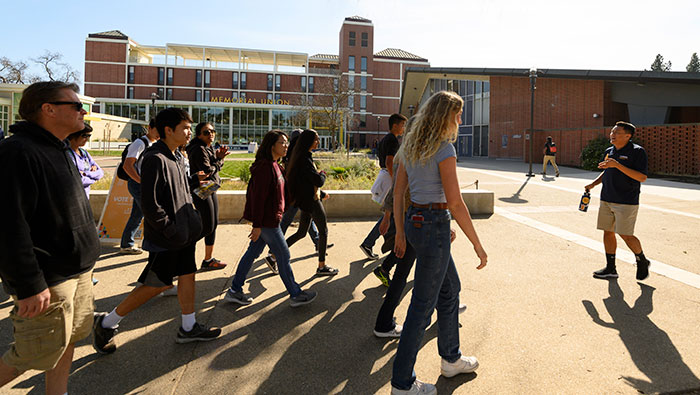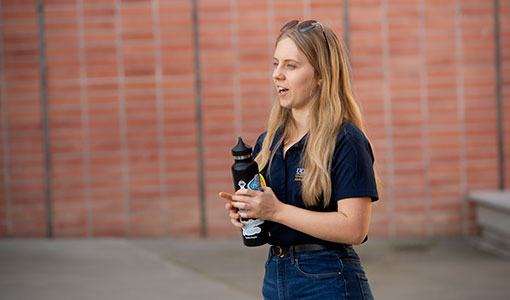
“Your leg muscles just get used to it,” said UC Davis food science major Maria Shaposhnikov.
She was talking about walking backward — the signature of the campus’s more than 100 beloved tour guides and its leading ambassadors to prospective students and their families.
While the approach of the COVID-19 pandemic led Undergraduate Admissions to suspend tours this spring, thousands of guides, like Shaposhnikov, have introduced generations of students to UC Davis and brought smiles to others familiar with their backward way.
“They’re like the heart and soul of the campus,” said Jessica Acuna, who has managed the tour program for more than three years.
Lots of ground to cover
Marketing research consistently shows that visiting campus and taking a tour highly influence students’ decisions to enroll at UC Davis.
Leading those tours isn’t easy.
The student guides learn a 90-minute route and 17-page script through what is physically the largest and academically the most comprehensive of the University of California’s 10 campuses. And they learn to adapt tours for different groups, like middle school students, and events, like conferences. Importantly, the script is only the beginning — guides also share their own experiences, often about how they found community on campus, where they study and the wealth of student resources they’ve explored.
“That’s what I think makes such a huge impact with students and parents,” Acuna said. “When people come to visit, they’re here to learn how student life is,” said Zach Luis of Torrance, California, who has given 230 tours over three years and is chair of the team that will recruit next year’s guides. “That’s not something they can easily Google.”
Telling the student story
Luis, a junior majoring in applied mathematics and economics, explained how he puts his own stories into his tours.
“I like to connect what a building is about to something I’ve experienced,” he said, mentioning the fun of petting fluffy therapy dogs in the Shields Library courtyard during midterms.
Luis emphasized the close-knit community he’s come to be a part of. “Friends have a way of finding each other through jobs, clubs or meeting randomly,” he said.
And he sees students relax, he added, when he tells them he struggled to decide on his majors. “College is a learning process. It’s where you get to discover yourself and what you’re passionate about.”

Training
While about 60 percent of UC Davis guides return each year, applicants go through group interviews with staff and veteran guides.
The hiring team particularly looks for Aggie pride, voice projection and dependability. During training, recruits are paired with experienced guides and can often be seen practicing the route or script while walking forward and later, backward.
To become certified, they successfully give a tour to a member of the guide recruitment team.
Shaposhnikov, a sophomore from Sunnyvale, California, trained earlier this year and has led 24 tours. She said the script has stuck with her since she learned it, but she had another obstacle to learn to avoid once she started practicing walking backward — a bush in a housing area. What kind of bush? “A prickly one,” she laughed.
The importance of being backward
“It’s not normal to walk backward, but you get the hang of it,” Luis said. “You learn the tricks.”
On his tours, he peeks at his group’s reflection in windows to see what might be in his path and glances down for any changes in the sidewalk lines that can warn him of a coming turn.
But just why is walking backward so important? Because guides are talking while they’re walking, the group can better hear them, and it’s more personable, Luis said.
The tour
Each guide is asked to commit to giving at least six tours a quarter, and in 2018-19 the group conducted more than 3,400 tours for nearly 72,200 people.
Historically, April is the busiest month for tours, but they are offered all year. The maximum tour group for prospective students ranges between 15 and 20, but other groups go up to 40.
For one of the weekday tours, about 100 students and family members gather in the Welcome Center for a 20- to 30-minute student-led presentation on the campus and admissions. Then they’re introduced to their guides, whose uniforms include a blue polo shirt, a big yellow button with their name, athletic shoes — and a smile.
The tour highlights offerings and qualities of the campus on its way to or through the Arboretum at Lake Spafford, Shields Library, the Quad, the Memorial Union, the Segundo residential area, the Activities and Recreation Center, California Hall and the Student Community Center.
Challenges and rewards
Guides pause a tour, often under a shady tree, to take questions or put some space between their group and another. Student and parent questions are not usually challenging, Shaposnikov said, but windy days and construction noise can tax guides’ voices.
Bringing a smile to the guides as they lead the tours are the waves and encouragement from those they pass and off-duty guides who — no matter the date — shout out, “Happy Birthday!”
Most of all, guides said helping students as they’re making one of their first important life decisions in rewarding.
“I feel really happy after, especially when they’re into it and asking questions,” Shaposhnikov said. ”I feel like I did something valuable with my time.”